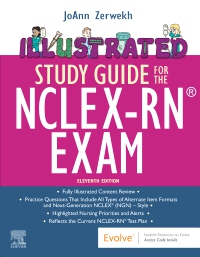
Illustrated Study Guide for the NCLEX-RN Exam Elsevier eBook on VitalSource, 11th Edition
Elsevier eBook on VitalSource

Who says studying for the NCLEX® can’t be fun? Illustrated Study Guide for the NCLEX-RN® Exam, 11th Edition uses colorful drawings and mnemonic cartoons to help students review and remember the nursing content found on the NCLEX-RN examination. A concise outline format makes it easier to study key facts, principles, and applications of the nursing process. More than 2,500 NCLEX exam-style questions on the Evolve website allow students to create practice exams, identify strengths and weaknesses, and review answers and rationales. Bringing nursing concepts to life, this study guide provides students a visual, unintimidating way to prepare for the NCLEX-RN exam.
Newer Edition Available
Illustrated Study Guide for the NCLEX-RN Exam - Elsevier E-Book on VitalSource
-
- NEW! Patient Scenarios and Next Generation NCLEX® (NGN) Examination-Style question types on the Evolve website familiarize students with these new types of questions
- NEW! The NCSBN’s clinical judgment model and six cognitive skills are reviewed in the context of preparing for the nursing profession and taking the NCLEX-RN® examination
- More than 2,500 review questions on the Evolve website allow students to practice test-taking in Study or Exam mode
- NEW! Pediatric content is moved into a separate new chapter and organized by body systems
- UNIQUE! Mnemonic cartoons provide a fun, easy way to review and remember key nursing concepts and disease processes
- UNIQUE! Integrated systems approach incorporates pediatric, adult, and older adult lifespan considerations for basic nursing care concepts
- Alternate item format questions on Evolve prepare students for the interactive question types on the NCLEX examination, including priority, drag-and-drop, and hot-spot (illustrated point-and-click) questions
- UNIQUE! Appendixes in each chapter summarize diagnostic tests, medications, and nursing procedures for quick reference
- Answers and rationales are provided for all review questions
- Priority Concepts at the beginning of each chapter assist students in concept-based nursing programs by focusing on priority nursing concepts
- Nursing Priority boxes make it easier for students to distinguish priorities of nursing care
- Test Alert boxes highlight concepts frequently found on the NCLEX test plan
- Adult content is presented in an easy-to-understand body systems approach, with separate chapters on psychosocial, maternity, newborn, and pediatric nursing care.
- Separate chapters on pharmacology and nursing management help students to focus on these areas of emphasis on the NCLEX examination
- Pharmacology tables make key drug information easy to find, with high-alert medications noted by a special icon
- Special icons distinguish pediatric and adult disorders, and identify Self-Care and Home Care content
-
- NEW! Patient Scenarios and Next Generation NCLEX® (NGN) Examination-Style question types on the Evolve website provide practice with these new types of questions
- NEW! Review of the NCSBN’s clinical judgment model and six cognitive skills helps to prepare you for the nursing profession and taking the NCLEX-RN® examination
- NEW! Pediatric content is moved into a separate new chapter and organized by body systems
-
1. Testing Strategies for the NCLEX-RN® Examination
2. Health Implications Across the Life Span
3. Concepts of Nursing Practice
4. Culture and Spiritual Awareness
5. Nursing Management
6. Ethical and Legal Concepts
7. Emergency and Disaster Preparedness and Bioterrorism
8. Pharmacology and Medication Administration
9. Homeostasis Concepts
10. Immune: Care of the Adult, Maternity, and Pediatric Clients
11. Cancer Concepts
12. Psychosocial Nursing Care
13. Integumentary: Care of Adult and Pediatric Clients
14. Sensory: Care of Adult and Pediatric Clients
15. Endocrine: Care of Adult, Maternity, and Pediatric Clients
16. Hematology: Care of Adult and Pediatric Clients
17. Respiratory: Care of Adult and Pediatric Clients
18. Vascular: Care of Adult Clients
19. Cardiac: Care of Adult, Maternity, and Pediatric Clients
20. Gastrointestinal: Care of Adult and Pediatric Clients
21. Hepatic and Biliary: Care of Adult and Pediatric Clients
22. Neurology: Care of Adult and Pediatric Clients
23. Musculoskeletal: Care of Adult and Pediatric Clients
24. Reproductive: Care of Adult and Pediatric Clients
25. Urinary-Renal: Care of Adult and Pediatric Clients
26. Maternity Nursing Care
27. Newborn Nursing Care
Appendix: Normal Laboratory Data
References and Resources



 as described in our
as described in our 